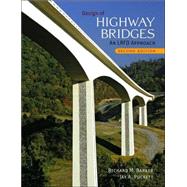
JAY A. PUCKETT, PhD, PE, is the V. O. Smith Professor of Civil and Architectural Engineering and Department Head at the University of Wyoming, and President of Bridge Tech, Inc., a consulting firm that specializes in software development for bridge engineering. With thirty years of experience in bridge research and development, he has developed software for the analysis and rating of bridge systems that is currently in use at over forty transportation agencies. Dr. Puckett is a consultant to AASHTO on their BridgeWare load rating and bridge design software. His research has involved several National Academy NCHRP projects.
| Preface | |
| Preface to the First Edition | |
| Introduction to Bridge Engineering | |
| A Bridge Is Key Element in a Transportation System | |
| Bridge Engineering in the United States | |
| Stone Arch Bridges | |
| Wooden Bridges | |
| Metal Truss Bridges | |
| Suspension Bridges | |
| Metal Arch Bridges | |
| Reinforced Concrete Bridges | |
| Girder Bridges | |
| Closing Remarks | |
| Bridge Specifications | |
| Implication of Bridge Failures on Practice | |
| Silver Bridge, Point Pleasant, West Virginia, December 15, 1967 | |
| I-5 and I-210 Interchange, San Fernando, California, February 9, 1971 | |
| Sunshine Skyway, Tampa Bay, Florida, May 9, 1980 | |
| Mianus River Bridge, Greenwich, Connecticut, June 28, 1983 | |
| Schoharie Creek Bridge, Amsterdam, New York, April 5, 1987 | |
| Cypress Viaduct, Loma Prieta Earthquake, October 17, 1989 | |
| Failures during Construction | |
| Bridge Engineera Planner, Architect, Designer, Constructor, and Facility Manager.References.Problems | |
| Aesthetics and Bridge Types | |
| Introduction | |
| Nature of the Structural Design Process | |
| Description and Justification | |
| Public and Personal Knowledge | |
| Regulation | |
| Design Process | |
| Aesthetics in Bridge Design | |
| Definition of Aesthetics | |
| Qualities of Aesthetic Design | |
| Practical Guidelines for Medium- and Short-Span Bridges | |
| Computer Modeling | |
| Web References | |
| Closing Remarks on Aesthetics | |
| Types of Bridges | |
| Main Structure below the Deck Line | |
| Main Structure above the Deck Line | |
| Main Structure Coincides with the Deck Line | |
| Closing Remarks on Bridge Types | |
| Selection of Bridge Type | |
| Factors to Be Considered | |
| Bridge Types Used for Different Span Lengths | |
| Closing Remarks on Selection of Bridge Types.References.Problems | |
| General Design Considerations | |
| Introduction | |
| Development of Design Procedures | |
| Allowable Stress Design | |
| Variability of Loads | |
| Shortcomings of Allowable Stress Design | |
| Load and Resistance Factor Design | |
| Design Limit States | |
| General | |
| Service Limit State | |
| Fatigue and Fracture Limit State | |
| Strength Limit State | |
| Extreme Event Limit State | |
| Principles of Probabilistic Design | |
| Frequency Distribution and Mean Value | |
| Standard Deviation | |
| Probability Density Functions | |
| Bias Factor | |
| Coefficient of Variation | |
| Probability of Failure | |
| Safety Index <$$$> | |
| Calibration of LRFD Code | |
| Overview of the Calibration Process | |
| Calibration Using Reliability Theory | |
| Calibration by Fitting with ASD | |
| Geometric Design Considerations | |
| Roadway Widths | |
| Vertical Clearances | |
| Interchanges | |
| Closing Remarks.References.Problems.4 Loads | |
| Introduction | |
| Gravity Loads | |
| Permanent Loads | |
| Transient Loads | |
| Lateral Loads | |
| Fluid Forces | |
| Seismic Loads | |
| Ice Forces | |
| Forces due to Deformations | |
| Temperature | |
| Creep and Shrinkage | |
| Settlement | |
| Collision Loads | |
| Vessel Collision | |
| Rail Collision | |
| Vehicle Collision | |
| Summary.References.Problems | |
| Influence Functions and Girder-Line Analysis | |
| Introduction | |
| Definition | |
| Statically Determinate Beams | |
| Concentrated Loads | |
| Uniform Loads | |
| Mullera Breslau Principle | |
| Bettia s Theorem | |
| Theory of Mullera Breslau Principle | |
| Qualitative Influence Functions | |
| Statically Indeterminate Beams | |
| Integration of Influence Functions | |
| Relationship between Influence Functions | |
| Mullera Breslau Principle for End Moments | |
| Automation by Matrix Structural Analysis | |
| Normalized Influence Functions | |
| AASHTO Vehicle Loads | |
| Influence Surfaces | |
| Summary.References.Problems | |
| System Analysis | |
| Introduction | |
| Safety of Methods | |
| Equilibrium for Safe Design | |
| Stress Reversal and Residual Stress | |
| Repetitive Overloads | |
| Fatigue and Serviceability | |
| Gravity Load Analysis | |
| Slaba Girder Bridges | |
| Slab Bridges | |
| Slabs in | |
| Table of Contents provided by Publisher. All Rights Reserved. |
The New copy of this book will include any supplemental materials advertised. Please check the title of the book to determine if it should include any access cards, study guides, lab manuals, CDs, etc.
The Used, Rental and eBook copies of this book are not guaranteed to include any supplemental materials. Typically, only the book itself is included. This is true even if the title states it includes any access cards, study guides, lab manuals, CDs, etc.